Abstract
SLATER'S theory1 of the origin of the ferroelectricity shown by potassium dihydrogen phosphate below 120° K. is based on the assumption that the proton of the O—H—O bond is situated in a double potential well. Above the Curie point, the proton is not permanently located in either well and moves between the two, giving the structure non-polar tetragonal symmetry. Below the Curie point the proton positions are ordered in accordance with the polar orthorhombic symmetry.
This is a preview of subscription content, access via your institution
Access options
Subscribe to this journal
Receive 51 print issues and online access
$199.00 per year
only $3.90 per issue
Buy this article
- Purchase on Springer Link
- Instant access to full article PDF
Prices may be subject to local taxes which are calculated during checkout
Similar content being viewed by others
References
Slater, J. C., J. Chem. Phys., 9, 16 (1941).
Bacon, G. E., and Pease, R. S., Proc. Roy. Soc., A, 220, 397 (1953).
Frazer, B. C., and Pepinsky, R., Acta Cryst., 6, 273 (1953).
Author information
Authors and Affiliations
Rights and permissions
About this article
Cite this article
PEASE, R., BACON, G. Ferroelectric Structure of Potassium Dihydrogen Phosphate. Nature 173, 443–444 (1954). https://doi.org/10.1038/173443b0
Issue Date:
DOI: https://doi.org/10.1038/173443b0
Comments
By submitting a comment you agree to abide by our Terms and Community Guidelines. If you find something abusive or that does not comply with our terms or guidelines please flag it as inappropriate.



